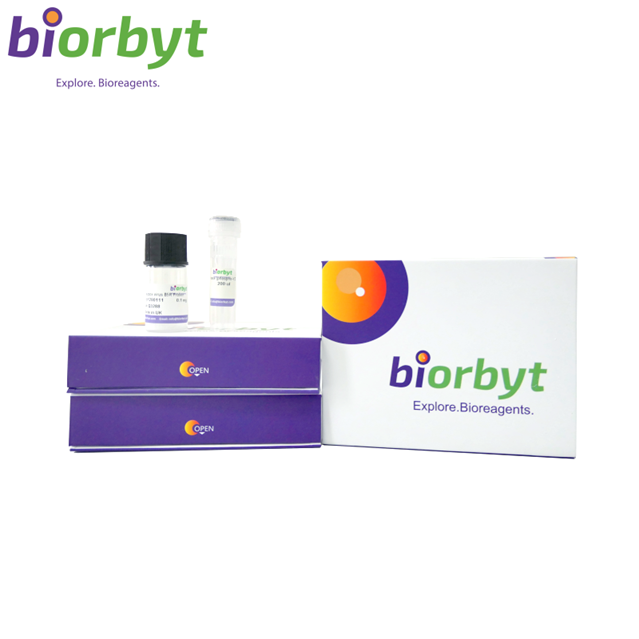You have no items in your shopping cart.
Cart summary

Recombinant Human Osteoprotegerin/Fc Chimera (rHuOPG-Fc)
Catalog Number: orb1495077
Product Properties
| Catalog Number | orb1495077 |
|---|---|
| Category | Proteins |
| Description | Osteoprotegerin (OPG) is a member of the TNFR superfamily that can act as a decoy receptor for RANKL. Binding of soluble OPG to sRANKL inhibits osteoclastogenesis by interrupting the signaling between stromal cells and osteoclastic progenitor cells, thereby leading to excess accumulation of bone and cartilage. OPG is expressed in a wide variety of tissues including adult heart, lung, kidney, liver, spleen, prostate, lymph node and bone marrow. OPG is secreted both as a monomeric and a dimeric protein. Its primary structure consists of seven distinct domains, four of which corresponds to the extracellular cysteine-rich domains of TNFR proteins and constitutes the soluble OPG. |
| Form/Appearance | Lyophilized from a 0.2m filtered concentrated solution in PBS, pH 7.4. |
| Buffer/Preservatives | Lyophilized from a 0.2m filtered concentrated solution in PBS, pH 7.4. |
| Purity | >90% by SDS-PAGE and HPLC analyses. |
| Purification | >90% by SDS-PAGE and HPLC analyses. |
| Protein Sequence | OPG 22-201: ETFPPKYLHYDEETSHQLLCDKCPPGTYLKQHCTAKWKTVCAPCPDHYYTDSWHTSDECLYCSPVCKELQYVKQECNRTHNRVCECKEGRYLEIEFCLKHRSCPPGFGVVQGTPERNTVCKRCPDGFFSNETSSKAPCRKHTNCSVFGLLLTQKGNATHDNICSGN SESTQKCGIDVTL Fc232: EPKSSDKTHTCPPCPAPEFEGAPSVFLFPPKPKDTLMISRTPEVTCVVVDVSHEDPEVKFNWYVDGVEVHNAKTKPREEQYNSTYRVVSVLTVLHQDWLNGKEYKCKVSNKALPTPIEKTISKAKGQPREPQVYTLPPSRDELTKNQVSLTCLVKGFYPSDIAVEWESNGQPENNYKTTPPVLDSDGSFFLYSKLTVDKSRWQQGNVFSCSVMHEALHNHYTQKSLSLSPGK |
| MW | Recombinant OPG/Fc contains 412 amino acid residues, including 180 residues from mature OPG (a.a 22-201) and 232 residues from the Fc protein of human IgG1, and has a calculated molecular mass of 46.5 kDa. As a result of glycosylation, the recombinant OPG/Fc migrates as a 49 kDa protein in SDS-PAGE under reducing conditions. |
| Application notes | We recommend that this vial be briefly centrifuged prior to opening to bring the contents to the bottom. Reconstitute in sterile distilled water or aqueous buffer containing 0.1% BSA to a concentration of 0.1-1.0 mg/mL. Stock solutions should be apportioned into working aliquots and stored at <-20C. Further dilutions should be made in appropriate buffered solutions. |
| Endotoxins | Less than 1EU/g of rHuOPG-Fc as determined by LAL method. |
| Source | Pichia. Pastoris. |
| Biological Activity | Fully biologically active when compared to the standard. Determined by its ability to neutralize the stimulation of U937 cells treated with 10 ng/ml of soluble RANKL. |
| Storage | This lyophilized preparation is stable at 2-8°C, but should be kept at -20°C for long term storage, preferably desiccated. Upon reconstitution, the preparation is stable for up to one week at 2-8°C. For maximal stability, apportion the reconstituted preparation into working aliquots and store at -20°C to -70°C. Avoid repeated freeze/thaw cycles. |
| Note | For research use only |
Images
Reviews
Recombinant Human Osteoprotegerin/Fc Chimera (rHuOPG-Fc) (orb1495077)
Based on 0 reviews
Participating in our Biorbyt product reviews program enables you to support fellow scientists by sharing your firsthand experience with our products.
Login to Submit a Review

